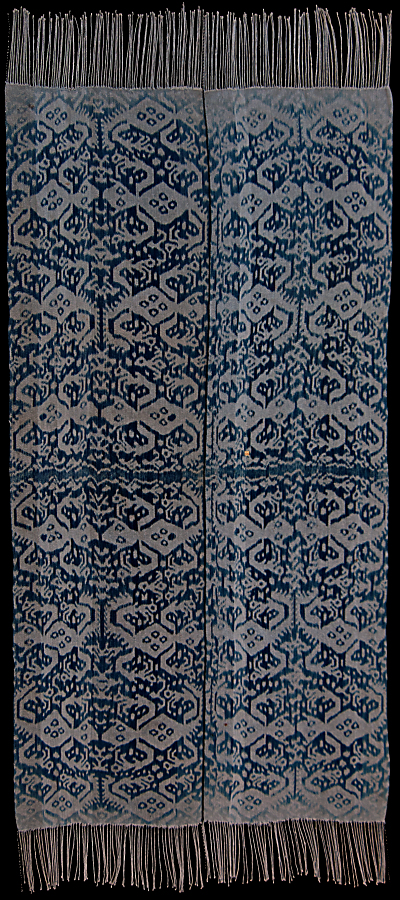| |
326 Timor, West Timor
Mau naek (men's wrap)  
|
| Locale: | Desa Hane, Amanuban Barat |
| Period: | Late 19th or early 20th c. |
| Yarn: | Cotton, hand-spun, medium |
| Technique: | Warp ikat |
| Panels: | 2 |
| Size: | 96.5 x 182 cm (3' 1" x 5' 11") LW: 1.89 |
| Weight: | 620 g (21.9 oz), 353 g/m2 (1.16 oz/ft2) |
| Design: | This striking old beti with its wild drawing has an asymmetric design, something rarely encountered in Amanuban. The entire field is covered in an array of 24 tokeh (geckos), 12 per panel. The geckos appear to hold up small birds on raised paws, a very unusual motif. Whereas such cloths are typically made of two identical panels that were ikated in parallel by appying ties on the two layers of a circular warp at the same time, here no such replication took place. Both panels are entirely different from one another, nor do they contain any inner replication. Every single twist and turn of the drawing lines was tied into the warp individually, representing a doubling of the typical workload for a cloth of this size. |
| Comment: | 'Full asli' Amanuban, made of handspun yarn and natural indigo. The design is very bold, and the cloth has a pleasant rustic feel. The yarn has the wildly irregular gauge that is typically found on 19th or very early 20th c. cloths, and is the most degraded we ever encountered (see Micro), also suggesting quite advanced age. Like many Timorese men's wraps the cloth tapers slightly. The width given above is the median of 94-99 cm. As Timorese weavers are used to working with circular warps which 'automatically' let them create two panels at the same time, in this case the weaver probably produced four panels, which she assembled into two identical cloths. There are slight differences in colour saturation along the cloth suggesting that the weaver had access to only limited amounts of indigo at a time, and dyed bundles of warp divided over five or perhaps even seven sessions, for slightly different durations. A few tiny, faded sirih spots have marked the cloth which is otherwise in perfect condition. This is the kind of cloth one needs to wear for a few days to fully appreciate its power. |
| Background: | Chapters on Timor and West Timor. |
| Exhibited: | Timor: Totems and Tokens, Museu do Oriente, Lisbon, 2019/20. |
| Published: | Timor: Totems and Tokens, 2019.
Ikat Textiles of Timor: Indonesian and Timor-Leste, 2025. |
| Compare: | 005 112 181 244 |
| Sources: | Origin confirmed by Pierre Dugard. Crocodile motif very similar to that in Yeager and Jacobson, Textiles of Western Timor, Fig. 47b. Overall similarity to Amanuban (Soe) selimut on Fig. 102. |
| |

©Peter ten Hoopen, 2024
All rights reserved.
|


